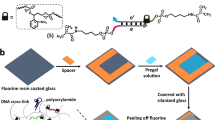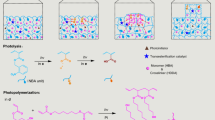Abstract
We have used a thermo-responsive polymer, poly-N-isopropyl acrylamide (PNI-PAAm), as a substratum for the culture of human dermal fibroblasts by conjugating it with collagen. The cells attached well, spread, and grew on the substratum, indicating that the polymer has no toxicity towards the cells. PNIPAAm is insoluble in water over the lower critical solution temperature (LCST; about 32°C) and reversibly solubilized below the LCST. Taking advantage of this conversion, monolayered fibroblasts cultured on the substratum containing the PNIPAAm over the LCST, were completely detachable from the substratum by simply lowering the temperature below the LCST, without the use of conventional detaching agents such as trypsin and EDTA. The detached cell sheet gradually aggregated and finally formed a multicellular spheroid. This polymer may provide a convenient and potentially useful technology for cell culture.
This is a preview of subscription content, access via your institution
Access options
Subscribe to this journal
Receive 12 print issues and online access
$209.00 per year
only $17.42 per issue
Buy this article
- Purchase on Springer Link
- Instant access to full article PDF
Prices may be subject to local taxes which are calculated during checkout
Similar content being viewed by others
References
Grinnell, F. 1978. Cellular adhesiveness and extracellular substrata. Int. Rev. Cytol. 53: 65–144.
Hynes, R.O. 1981. Fibronectin and its relation to cellular structure and behavior, p. 295–334. In: Cell Biology of Extracellular Matrix. Hay, E. D. (Ed.) Plenum Press, New York.
Bissell, M.J., Hall, H.G. and Parry, G. 1982. How does the extracellular matrix direct gene expression? J. Theoret. Biol. 99: 31–68.
Imai, Y., Watanabe, A. and Masuhara, E. 1979. A new cell culture biocompatibility test system for materials. Trans. Am. Soc. Artif. Intern. Organs. 25: 299–304.
Tanzawa, H., Nagaoka, S., Suzuki, J., Kobayashi, S., Masubuchi, Y. and Kikuchi, T. 1980. Cell adhesion and growth on the surface of synthetic hydrogels, p. 189–211. In: Biomedical Polymers; Polymeric Materials and Pharmaceuticals for Biomedical Use. Goldberg, E. P., and Nakajima, A. (Eds.). Academic Press, New York.
Birdi, K.S. 1981. Cell adhesion on solids and the role of surface forces. J. Theoret. Biol. 93: 1–5.
Valk, P., Pelt, A.W.J., Busscher, H.J., Jong, H.P., Wildevuur, Ch.R.H. and Arends, J. 1983. Interaction of fibroblasts and polymer surfaces: relationship between surface free energy and fibroblast spreading. J. Biomed. Mater. Res. 17: 807–817.
Heskins, M. and Guillet, J.E. 1968. Solution properties of Poly(N-isopropylacrylamide). J. Macromol. Sci.-Chem., A2(8): 1441–1455.
Kleinman, H.K., Klebe, R.J. and Martin, G.R. 1981. Role of collagenous matrices in the adhesion and growth of cells. J. Cell Biol. 88: 473–485.
Fujishige, S. 1987. Intrinsic viscosity-molecular weight relationships for poly(N-isopropylacrylamide) solutions. Poly. J. 19: 297–300.
Yoshizato, K., Kikuyama, S. and Shioya, N. 1980. Stimulation of glucose utilization and lactate production in cultured human fibroblasts by thyroid hormone. Biochim. Biophys. Acta 627: 23–29.
Author information
Authors and Affiliations
Rights and permissions
About this article
Cite this article
Takezawa, T., Mori, Y. & Yoshizato, K. Cell Culture on a Thermo-Responsive Polymer Surface. Nat Biotechnol 8, 854–856 (1990). https://doi.org/10.1038/nbt0990-854
Received:
Accepted:
Issue Date:
DOI: https://doi.org/10.1038/nbt0990-854
This article is cited by
-
Cell Sheet Technology: An Emerging Approach for Tendon and Ligament Tissue Engineering
Annals of Biomedical Engineering (2024)
-
Tissue-Engineered 3D In Vitro Disease Models for High-Throughput Drug Screening
Tissue Engineering and Regenerative Medicine (2023)
-
Recent advances in cell sheet technology for bone and cartilage regeneration: from preparation to application
International Journal of Oral Science (2019)
-
Infused polymers for cell sheet release
Scientific Reports (2016)
-
Superiority of three-dimensional stem cell clusters over monolayer culture: An archetype to biological application
Macromolecular Research (2016)



